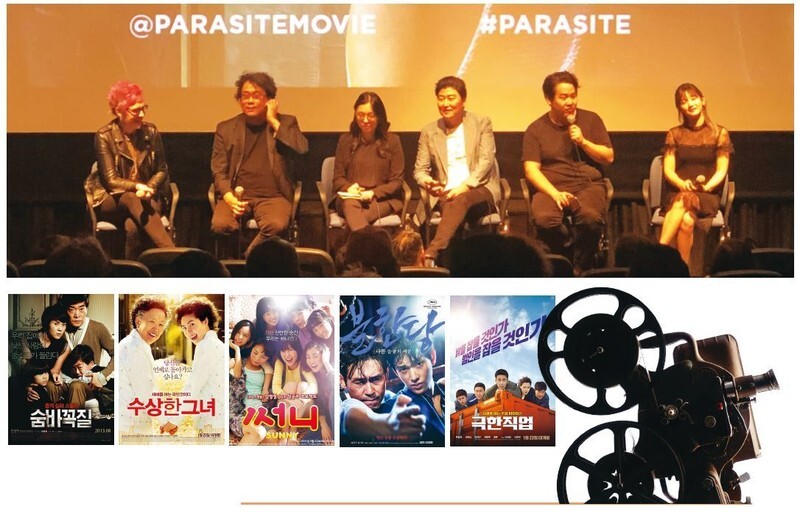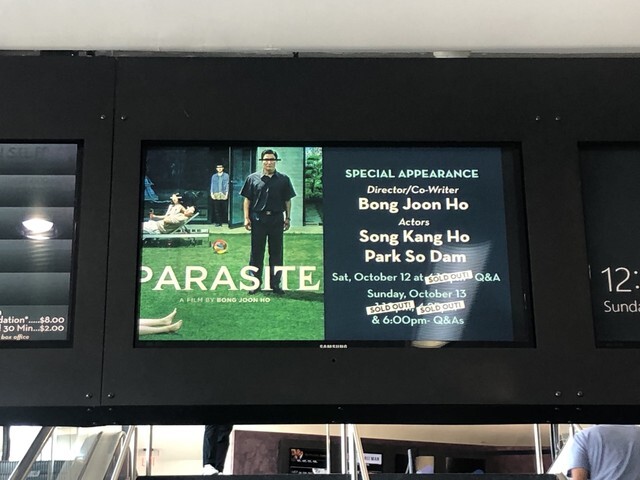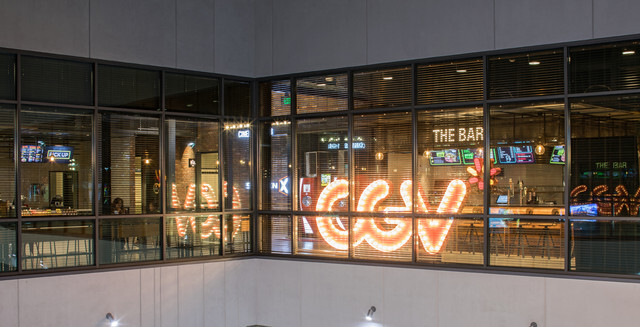hankyoreh
Links to other country sites 다른 나라 사이트 링크
[Reportage] The rise of Korean film on the global stage
This year marks the centennial of the first Korean film, “Fight for Justice,” which debuted at the Dansungsa Theater on Oct. 27, 1919. Korean cinema has undergone enormous advancements since then. In May, the Hankyoreh began looking back at the path traveled by Korean film, sharing the stories of lost works, South Korean film stars, North Korean cinema, and women’s movies in an inaugural feature series titled “100 Years of Korean Film, 100 Works,” which highlights 100 quintessential Korean films. Now it is going beyond simply looking back on and assessing Korean film’s past and present to make predictions for its future. These days, Korean cinema is envisioning the “globalization of K-movies”: venturing beyond the domestic market into those of other Asian countries -- and even Hollywood itself, the home of film. As another 100 years begins, can Korean film shift its position from the periphery of the global film industry to its epicenter? This two-part series will explore the possibilities.

“Parasite” sells out US screenings
This was the screening information for the Korean film “Parasite” shown on the display at the Landmark Theater in Los Angeles at 12:40 pm on Oct. 12. Not only were there no more tickets available for the 1:10 pm showing that day -- where a “conversation with the audience” was scheduled with director Bong Joon-ho and actors Song Kang-ho and Park So-dam -- but “sold out” announcements were already up for the 11:35 am, 4:25 pm, and 6 pm screenings the following day. In front of the theater, a dozen or so people had been in line for the past 30 minutes waiting to go inside. As the movie was set to start, not a single empty seat could be found among the 300 in the theater.
Laughter rang out from the seats nonstop throughout the film. Bong’s characteristic humor has struck a chord with viewers of all nationalities. The only difference from a Korean audience was the somewhat more enthusiastic response from the viewers. As the director’s name came up in the ending credits after the film, it was met with applause, whistles, and cries of “fantastic.” When Bong and the actors took the stage, most of the viewers stood up to cheer. The conversation lasted a little over 20 minutes, with a dozen or so questions about the participants’ response to the film’s Cannes honors, behind-the-scenes stories about the filming, and US box office predictions before the moderator declared that time was up.
Tanaz, 31, was at the theater with her boyfriend. “I’m a huge fan of Bong Joon-ho, so I booked tickets for the first day of the early run, and I was really counting the days,” she said.
“I loved the unique sense of humor, which you don’t see in American films, and the powerful and idiosyncratic approach in dealing with class issues,” she added, flashing a “thumbs up” sign.
“Parasite” part of vanguard eyeing US marketThe US debut of “Parasite” is being viewed as a test case for future Korean films. If the winner of the Cannes Palme d’Or prize proves commercially successful in America -- and even gets honored at the Academy Awards next February -- Korean cinema will be poised to make a major stride from the fringes to center stage.
Positive signals are all around. In its first week, “Parasite” raked in US$376,264 in early runs after debuting on Oct. 11 at three theaters: the Landmark and ArcLight Hollywood in LA and the IFC Center in New York. Averaging US$125,421 per theater, it was the highest total ever for a foreign-language film premiering in North America. As of Oct. 18, “Parasite” had debuted at a total of 33 theaters in Boston, Chicago, San Francisco, and Washington, DC, ranking 10th in the US box office 10 days after its release and 11th for its second weekend. By Oct. 24, its cumulative earnings had passed US$2 million.
Critics and audiences have showered the film with praise. It had a “freshness” rating of 99% on the film review site Rotten Tomatoes and a score of 95 on the review aggregation site Metacritic. Celebrated directors Martin Scorsese and James Gunn have lauded it on social media as the “best film of the year.” Its Oscar prospects are looking brighter after Bong received “Hollywood Filmmaker Award” honors at the 2019 Hollywood Film Awards.
Tom Quinn, CEO of the film’s North American distributor Neon, said he vowed to distribute “Parasite” after receiving the script in November of last year.
“I can’t jump to any conclusions, but we’re anticipating awards in major Oscar categories. If it does win, it will be a symbolic illustration of recent changes in the Academy Awards,” he predicted. “With Oscar recognition in addition to Cannes, it will mean a very different stature for Korean film from the past.”

Alongside the success of “Parasite,” the Korean film industry has been speeding up its efforts to make inroads into the US market. Its aim is to find new opportunities beyond the domestic film market, which has remained stagnant with cumulative viewership in the range of 200 million admissions for several years now. The US, which ranks as one of the world’s two biggest markets alongside China, accounts for 30% of global box office sales.
Because both the physical and human infrastructure of the global film industry is concentrated in the US, success in America translates to success around the world.
The South Korean film distributor that has taken the lead in targeting the American market is CJ ENM, which has also invested the most money in the South Korean market. This distributor is partnering with American studios such as Universal and MGM to remake films that were big hits in South Korea, including “Hide and Seek,” “Miss Granny,” “The Merciless,” and “Extreme Job.
CJ ENM is developing 12 films for release in the US, including new cinematic collaborations such as “Endings, Beginnings,” “Press Play,” and “Aurora.” While this isn’t the first time that successful Korean films have been optioned and remade by Hollywood (“Old Boy” and “My Sassy Girl” are earlier examples), it’s almost unheard of for a Korean company to collaborate with such prestigious American studios.
“We’re targeting the American market based on the brand image and network we’ve built since launching our direct distribution business in the US in 2009 and based on original intellectual property that enables us to take the lead in joint film productions,” said Koh Gyeong-beom, head of the overseas business division at CJ ENM’s film business headquarters.
“We’ve achieved success with various remakes of ‘Miss Granny’ and ‘Sunny’ for China, Vietnam, Japan, and Indonesia, and we think that strategy is going to work in the US as well,” Koh explained.
One person who sees this strategy as clever is Peter Cramer, president of Universal Pictures, the studio that’s partnering with CJ ENM for “Sunny” and “Extreme Job.”
“In the television industry, you see IP [intellectual property] being reworked for several formats, but there’s little precedent for doing various remarks of a single film as CJ has done. Considering that Hollywood is running short on ideas, CJ’s IP is very attractive,” Cramer said.
More granular targeting is another strategy for increasing the likelihood of success. This technique was inspired by observation of recent film trends in the US: mid- and low-budget films have been making more money, and films targeted at people of color, and Hispanics in particular, have been selling more tickets. A prime example is the development of a Spanish-language version of “My Sassy Girl” in partnership with Pantelion Films and an English-language version with MGM.
“We started shooting ‘Miss Granny’ [the working title] this month. The film has a wide range of elements that Latino viewers will love, given their emotional affinity with Koreans: family-centered feeling, comedy, music, and a fantastic ambience. We’re planning to release the film on a large scale, in 75 American cities and throughout Mexico and South America,” said Edward Allen, chief operating officer of Pantelion Films.
American film executives are bullish on the prospects of Korean films making it in the US. “I think the expansion of Korean content can enjoy some synergy through the Korean Wave, with K-pop in the vanguard, and OTT [over-the-top] video streaming platforms such as Netflix,” said Tom Quinn, CEO of film distributor Neon.
“Another positive factor is the outstanding originality of directors like Bong Joon-ho, Park Chan-wook, and Kim Jee-woon, who already have their own fan base in the US.”

Compared to the “software” of film content, the “hardware” of theater expansion is still at the embryonic phase. So far, the only game in town is CJ CGV, which has two theaters in American neighborhoods with a large Korean population: CGV LA (3 screens, 600 seats), near Hollywood, and CGV Buena Park (8 screens, 1,187 seats), in Orange County.
The company is planning to open a third branch (14 screens, 2,000 seats) in the first half of 2020 in San Francisco, a city with a smaller percentage of Korean residents. That theater is likely to serve as a litmus test for the feasibility of Korean companies opening more theaters in the US.
But the slow growth of Korean-owned theaters doesn’t mean Korean companies haven’t had any success in this area. The technology behind 4DX theaters, which cater to all the senses, and ScreenX theaters, which display the film not just in front but on the sides as well, are powerful weapons that could pry open the American theater market.
CJ 4DPlex is currently operating a total of 59 of these enhanced viewing screens in the US alone: 27 with 4DX and 32 with ScreenX. Over the past 10 years, CJ has produced 4DX versions of over 400 Hollywood films. 4DX technology was also applied to the trailers of upcoming films “Star Wars: The Rise of Skywalker” (December), “Ford v Ferrari” (December), and “Top Gun: Maverick” (June 2020) for demos that were screened for each studio at 4DX Lab, operated by 4DPlex; talks are currently underway about producing 4DX versions of those films.
“After selecting the content that would work best with 4DX treatment through close deliberations with major Hollywood studios such as Paramount and Fox, we apply the 4D coding to the original film three weeks before release,” said Choe Yeon-cheol, director of the American branch of CJ 4DPlex.
“ScreenX versions of films have gotten rave reviews when they showed in the US, including ‘Bohemian Rhapsody’ last year and the BTS concert film ‘Love Yourself in Seoul’ this year. Since it’s relatively inexpensive to install ScreenX, a technology that originated in Korea, there’s a good chance we can build the market. These technological developments and upgrades are part of a strategy aimed at not just the US but at the global market.”
By Yoo Sun-hui, staff reporter
Please direct comments or questions to [english@hani.co.kr]

Editorial・opinion
![[Editorial] Does Yoon think the Korean public is wrong? [Editorial] Does Yoon think the Korean public is wrong?](https://flexible.img.hani.co.kr/flexible/normal/500/300/imgdb/original/2024/0417/8517133419684774.jpg) [Editorial] Does Yoon think the Korean public is wrong?
[Editorial] Does Yoon think the Korean public is wrong?![[Editorial] As it bolsters its alliance with US, Japan must be accountable for past [Editorial] As it bolsters its alliance with US, Japan must be accountable for past](https://flexible.img.hani.co.kr/flexible/normal/500/300/imgdb/original/2024/0417/6817133413968321.jpg) [Editorial] As it bolsters its alliance with US, Japan must be accountable for past
[Editorial] As it bolsters its alliance with US, Japan must be accountable for past- [Guest essay] Amending the Constitution is Yoon’s key to leaving office in public’s good graces
- [Editorial] 10 years on, lessons of Sewol tragedy must never be forgotten
- [Column] A death blow to Korea’s prosecutor politics
- [Correspondent’s column] The US and the end of Japanese pacifism
- [Guest essay] How Korea turned its trainee doctors into monsters
- [Guest essay] As someone who helped forge Seoul-Moscow ties, their status today troubles me
- [Editorial] Koreans sent a loud and clear message to Yoon
- [Column] In Korea’s midterm elections, it’s time for accountability
Most viewed articles
- 1Samsung barricades office as unionized workers strike for better conditions
- 2[Column] The clock is ticking for Korea’s first lady
- 3[Editorial] When the choice is kids or career, Korea will never overcome birth rate woes
- 4Why Israel isn’t hitting Iran with immediate retaliation
- 5[News analysis] After elections, prosecutorial reform will likely make legislative agenda
- 6S. Korea, Japan reaffirm commitment to strengthening trilateral ties with US
- 7Japan officially says compensation of Korean forced laborers isn’t its responsibility
- 8[Editorial] As it bolsters its alliance with US, Japan must be accountable for past
- 9[Editorial] Does Yoon think the Korean public is wrong?
- 10[Guest essay] How Korea turned its trainee doctors into monsters